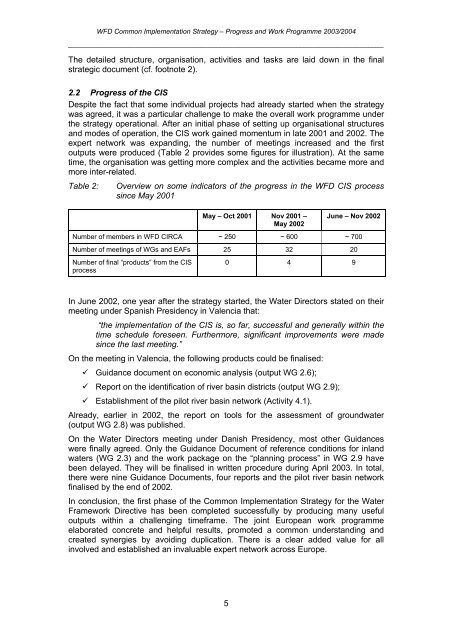WATECO - 2003 - Common implementation strategy for the Water Frame
WATECO - 2003 - Common implementation strategy for the Water Frame
WATECO - 2003 - Common implementation strategy for the Water Frame
Create successful ePaper yourself
Turn your PDF publications into a flip-book with our unique Google optimized e-Paper software.
WFD <strong>Common</strong> Implementation Strategy – Progress and Work Programme <strong>2003</strong>/2004<br />
___________________________________________________________________________________<br />
The detailed structure, organisation, activities and tasks are laid down in <strong>the</strong> final<br />
strategic document (cf. footnote 2).<br />
2.2 Progress of <strong>the</strong> CIS<br />
Despite <strong>the</strong> fact that some individual projects had already started when <strong>the</strong> <strong>strategy</strong><br />
was agreed, it was a particular challenge to make <strong>the</strong> overall work programme under<br />
<strong>the</strong> <strong>strategy</strong> operational. After an initial phase of setting up organisational structures<br />
and modes of operation, <strong>the</strong> CIS work gained momentum in late 2001 and 2002. The<br />
expert network was expanding, <strong>the</strong> number of meetings increased and <strong>the</strong> first<br />
outputs were produced (Table 2 provides some figures <strong>for</strong> illustration). At <strong>the</strong> same<br />
time, <strong>the</strong> organisation was getting more complex and <strong>the</strong> activities became more and<br />
more inter-related.<br />
Table 2:<br />
Overview on some indicators of <strong>the</strong> progress in <strong>the</strong> WFD CIS process<br />
since May 2001<br />
May – Oct 2001 Nov 2001 –<br />
May 2002<br />
June – Nov 2002<br />
Number of members in WFD CIRCA ~ 250 ~ 600 ~ 700<br />
Number of meetings of WGs and EAFs 25 32 20<br />
Number of final “products” from <strong>the</strong> CIS<br />
process<br />
0 4 9<br />
In June 2002, one year after <strong>the</strong> <strong>strategy</strong> started, <strong>the</strong> <strong>Water</strong> Directors stated on <strong>the</strong>ir<br />
meeting under Spanish Presidency in Valencia that:<br />
“<strong>the</strong> <strong>implementation</strong> of <strong>the</strong> CIS is, so far, successful and generally within <strong>the</strong><br />
time schedule <strong>for</strong>eseen. Fur<strong>the</strong>rmore, significant improvements were made<br />
since <strong>the</strong> last meeting.”<br />
On <strong>the</strong> meeting in Valencia, <strong>the</strong> following products could be finalised:<br />
Guidance document on economic analysis (output WG 2.6);<br />
Report on <strong>the</strong> identification of river basin districts (output WG 2.9);<br />
Establishment of <strong>the</strong> pilot river basin network (Activity 4.1).<br />
Already, earlier in 2002, <strong>the</strong> report on tools <strong>for</strong> <strong>the</strong> assessment of groundwater<br />
(output WG 2.8) was published.<br />
On <strong>the</strong> <strong>Water</strong> Directors meeting under Danish Presidency, most o<strong>the</strong>r Guidances<br />
were finally agreed. Only <strong>the</strong> Guidance Document of reference conditions <strong>for</strong> inland<br />
waters (WG 2.3) and <strong>the</strong> work package on <strong>the</strong> “planning process” in WG 2.9 have<br />
been delayed. They will be finalised in written procedure during April <strong>2003</strong>. In total,<br />
<strong>the</strong>re were nine Guidance Documents, four reports and <strong>the</strong> pilot river basin network<br />
finalised by <strong>the</strong> end of 2002.<br />
In conclusion, <strong>the</strong> first phase of <strong>the</strong> <strong>Common</strong> Implementation Strategy <strong>for</strong> <strong>the</strong> <strong>Water</strong><br />
<strong>Frame</strong>work Directive has been completed successfully by producing many useful<br />
outputs within a challenging timeframe. The joint European work programme<br />
elaborated concrete and helpful results, promoted a common understanding and<br />
created synergies by avoiding duplication. There is a clear added value <strong>for</strong> all<br />
involved and established an invaluable expert network across Europe.<br />
5
















